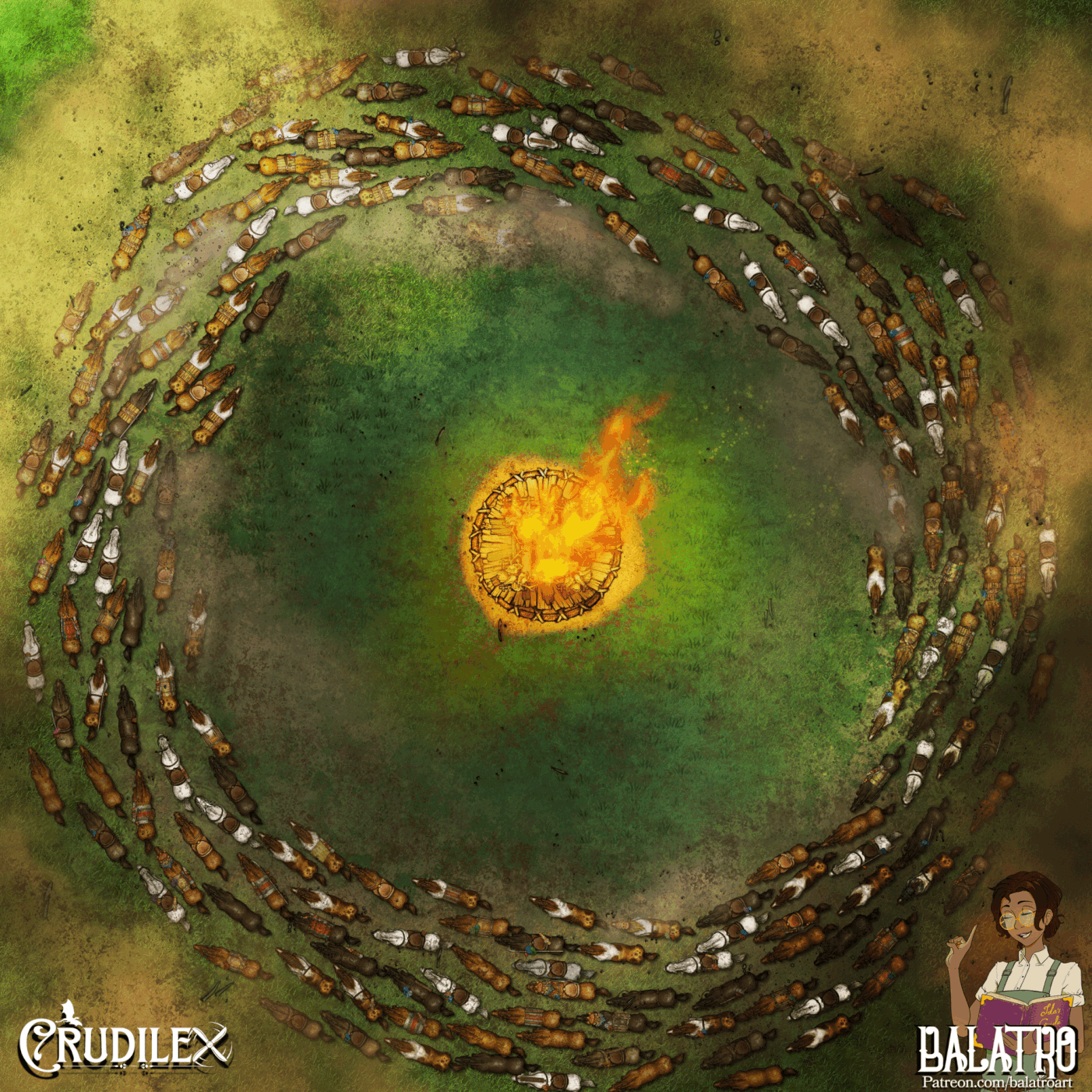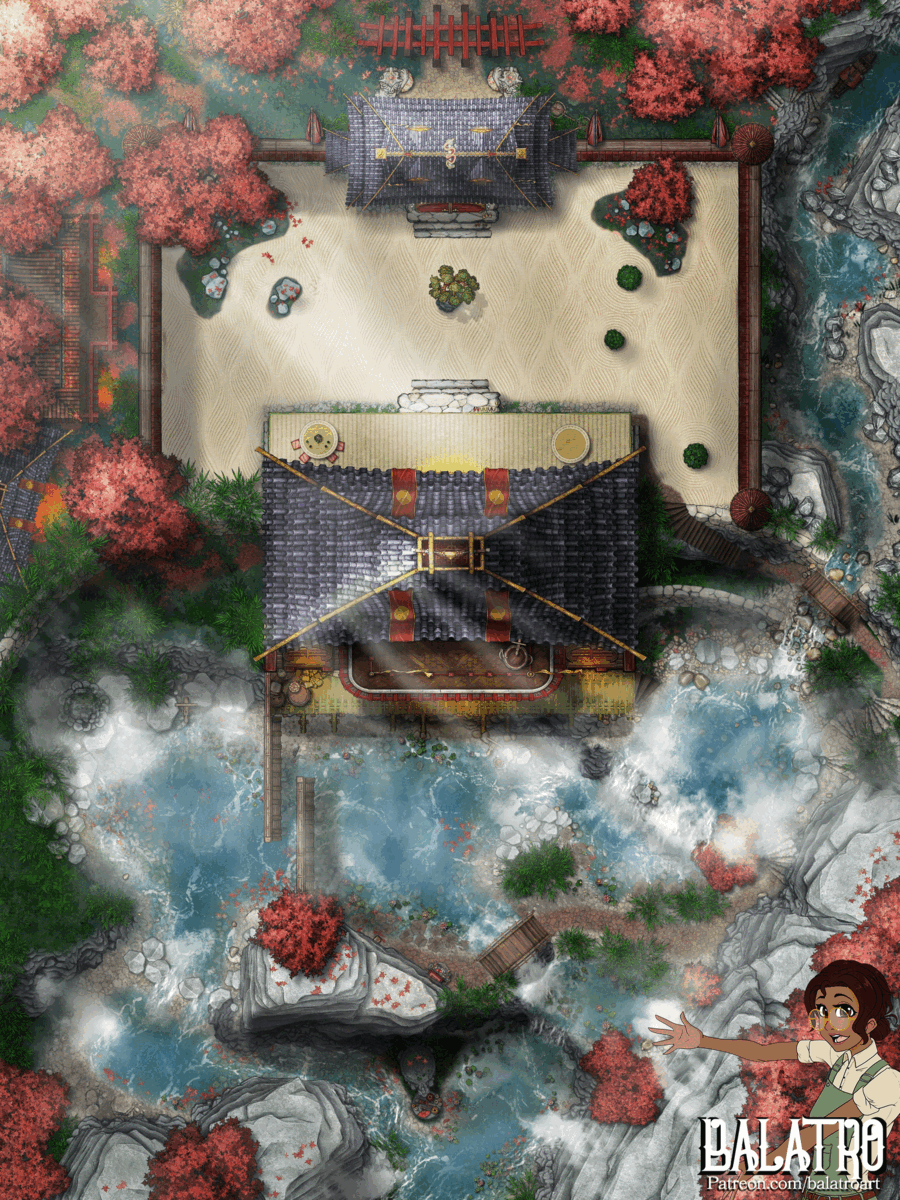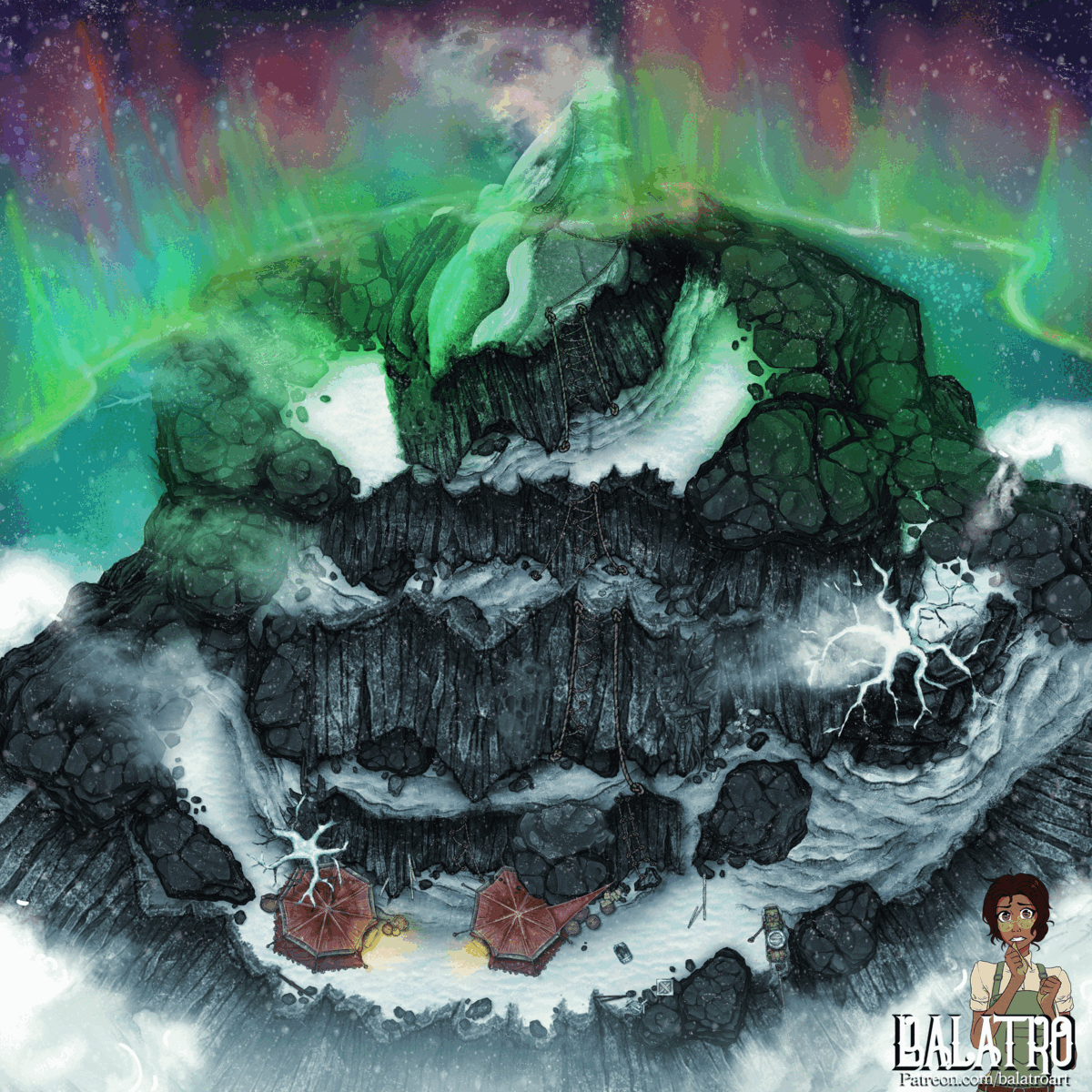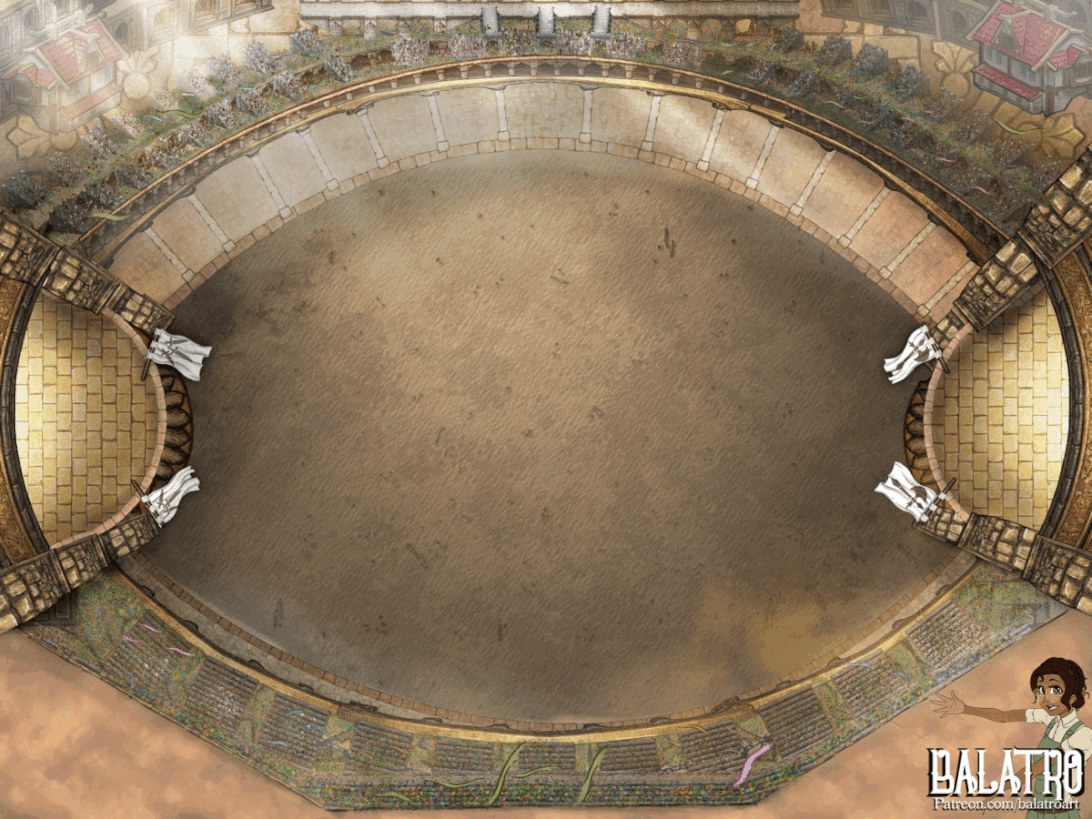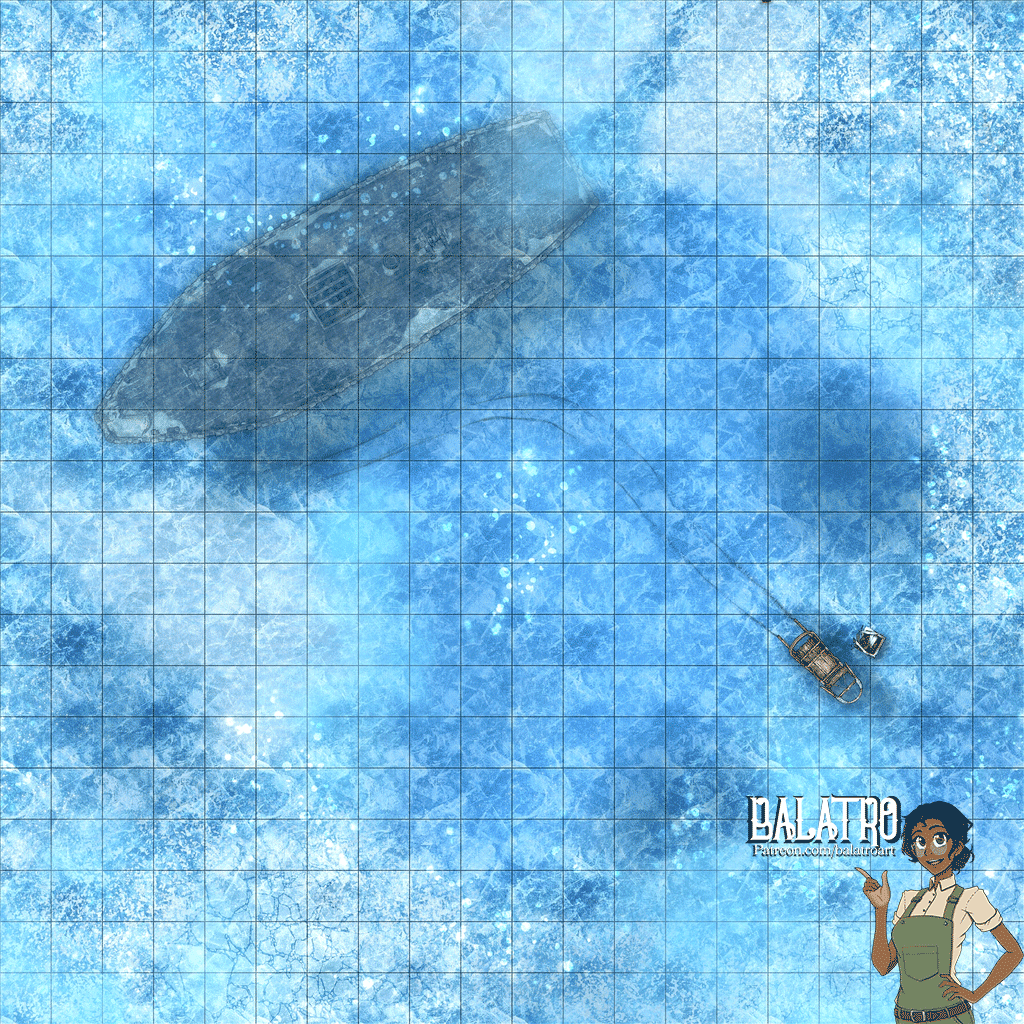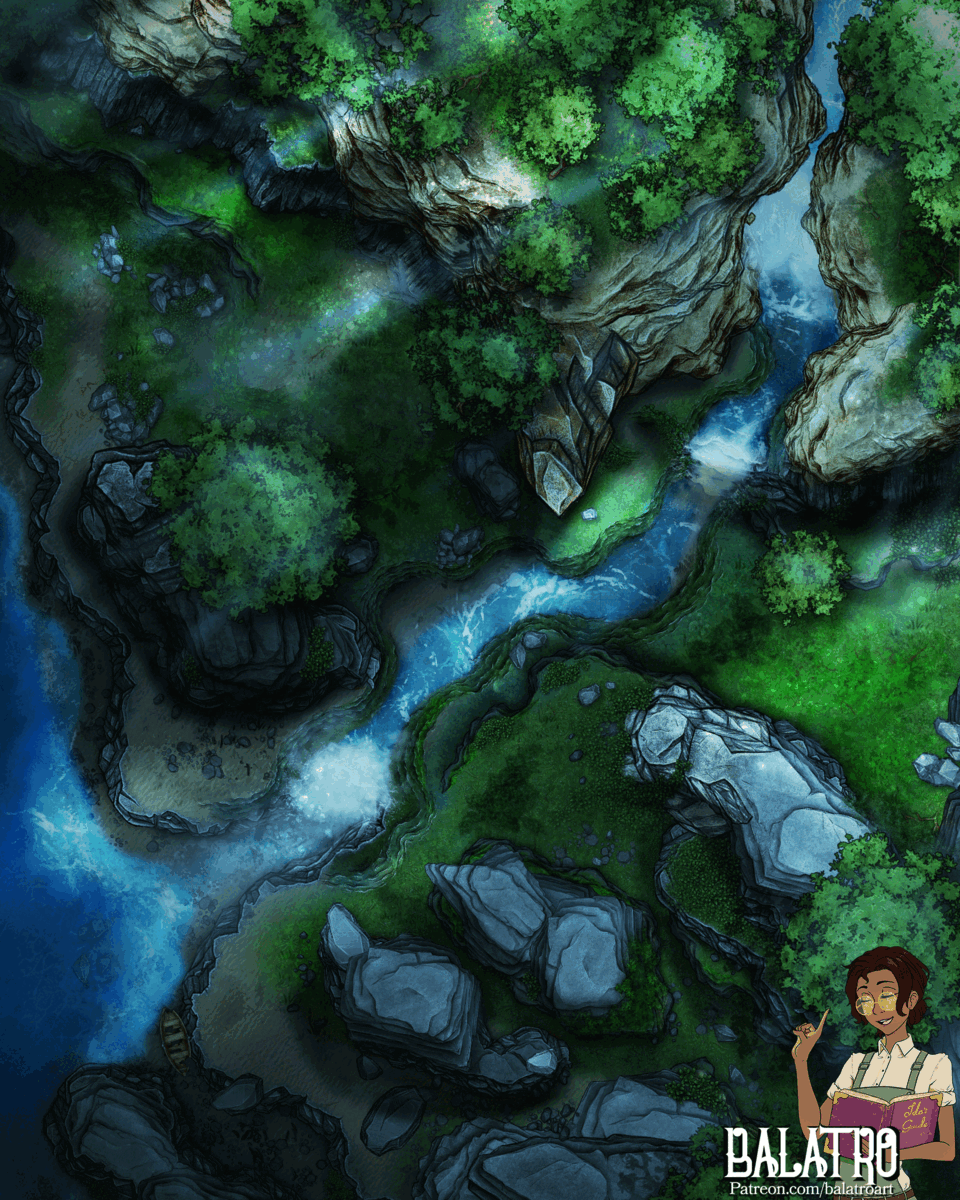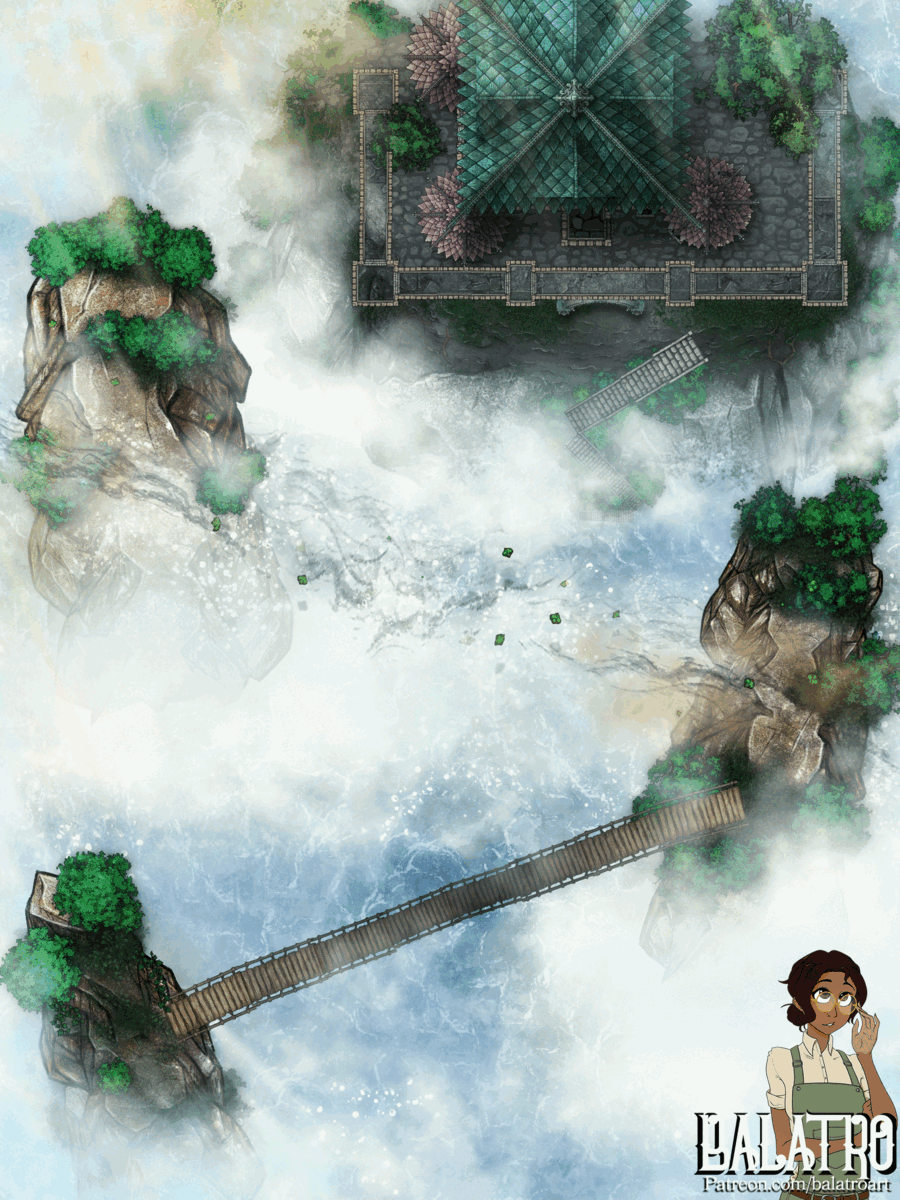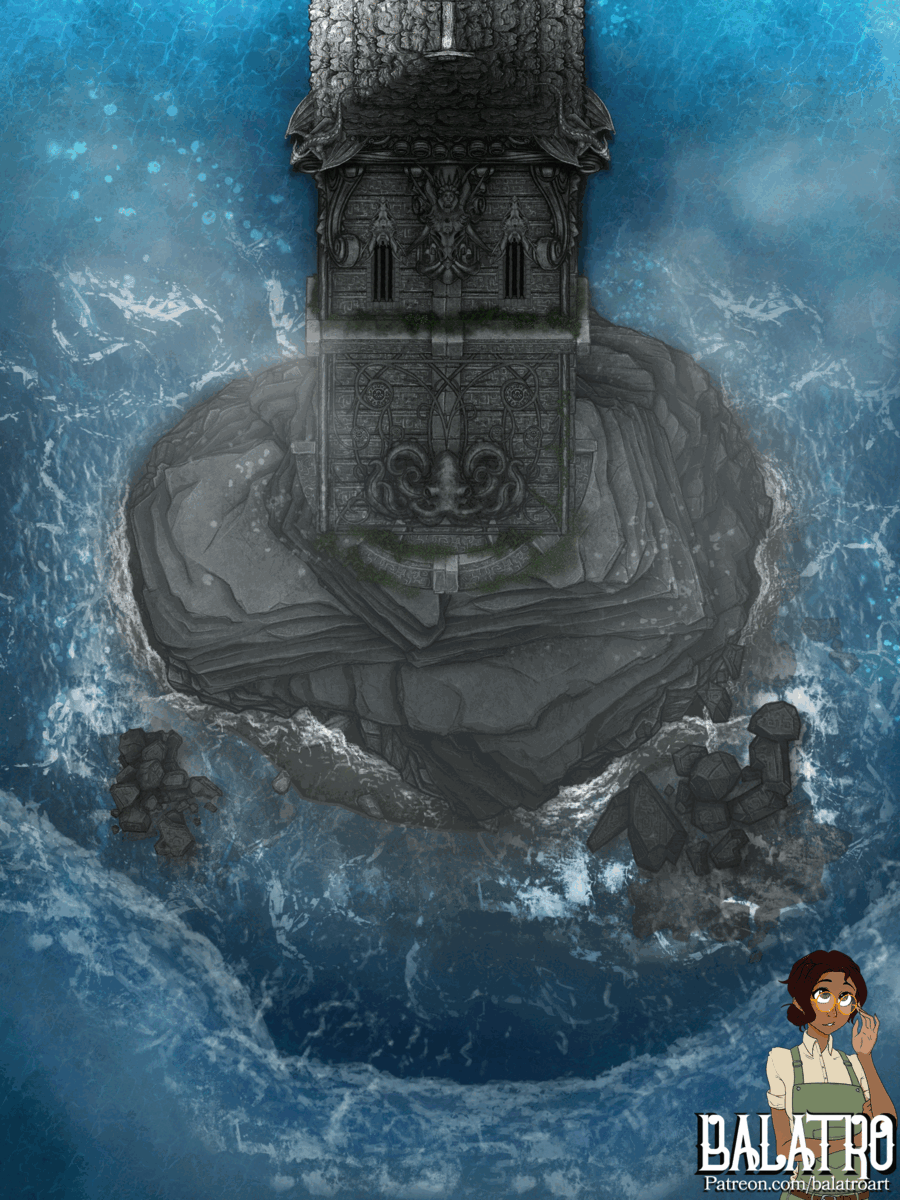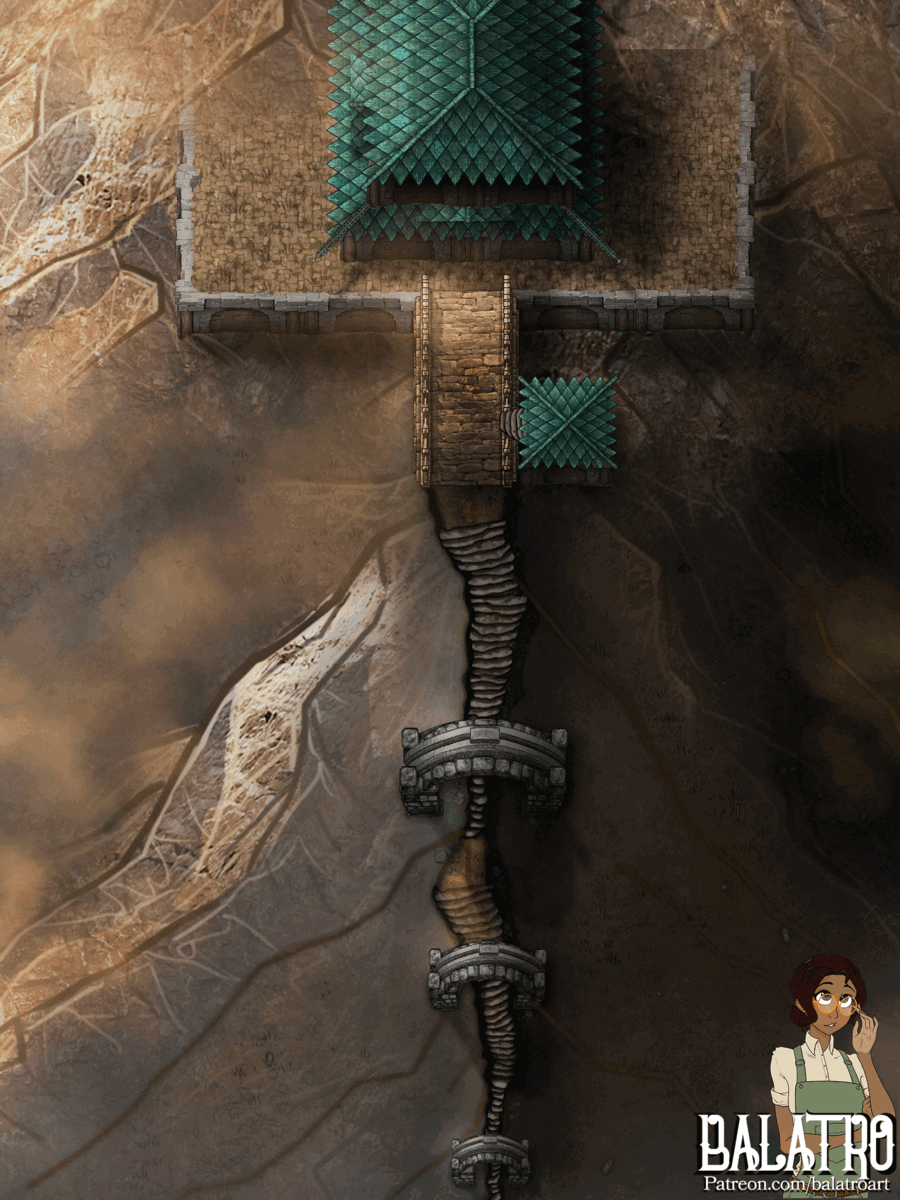
Okugai
Okugai is an isolated empire deeply rooted in ancient traditions and strict hierarchical systems. Ruled by the immortal Kozo an unquestioned emperor who has outlived all his subjects for ages, yet fractured by three warring Shogun fiefdoms (Bohai, Saiichuu, and Yasumasa) locked in a decades-long civil struggle; its northern peaks, the Aarosh Mountains, guard the shifting spirit realms of Nocturne and griffin-queen Aarosh’s court, while beneath them lie stilt-cities, hidden fox-spirit shrines, and warring samurai armies all sworn to the same emperror; Its coast is dotted with islands like Wugui, home to nomadic Tortle eager for citizenship. Despite its outward strength, the empire is weighed down by its internal conflicts, the mysterious powers supporting rebel factions, and the weight of centuries-old customs that even the most ambitious rulers cannot easily change.
Battlemaps set in this location
The Aarosh Mountains
The Aarosh Mountains stretch across the far northern border of Okugai, forming the final threshold between the waking world and the dreaming realm of Spirits, known as Nocturne. To the south, the mortal world operates on logic, order, and predictability. But beyond the peaks lies a land governed by thought and emotion.
In Nocturne, the landscape is shaped by the moods and ideals of the Ninoten—formless spirits that embody pure concepts. When a river spirit grieves, its waters may spill over in sorrow. When a mountain spirit is enraged, the very peak might uproot and march for miles. The land is alive and ever-changing to reflect the shifting inner lives of its denizens. The Aarosh Mountains stand as a sacred border between these two realities. Named after Aarosh, the Queen of Griffins, a sovereign of the skies believed to possess the most advanced intelligence in all of Crudilex. It is said her wings rest on either side of the ridge, both realms granting her a mastery of both dreams and logic.
Under Aarosh's silent guidance, a devoted order known as the Mushi Guardians serves as intermediaries. These monk-like investigators dwell among the mountains, tasked with maintaining peace between the spirits of Nocturne and the often-fearful mortals of the south. Walking the edge of both worlds—interpreters, diplomats, and, when necessary, warriors
Wing of Aarosh
Aarosh is no kind spirit. Intelligence does not guarantee empathy, and her brilliance offers no comfort to those who dare invade her territory. Doing so is a death sentince not through a monstrous furiosity, but precise and unrelenting understanding. Her violence is never the same twice, not because she is erratic, but because her grasp of her prey is so absolute that no predictable defense can be mounted. Yet, if by some miracle one were to survive the Wing of Aarosh and the high, furious gales that circle her domain and the talons of her children, they might find something wholly unexpected. Nestled atop the peaks is a palace of marble colonnades and soulstone-lit floors. The roost of Aarosh is less of a monster’s nest and much more a court of judgment.
Aarosh presides as arbiter. Dignitaries from every great capital across Crudilex send envoys, if they are brave or desperate enough, to entreat her counsel. The laws and customs of all nations are gathered, debated among the griffins, and weighed. It is said that griffins have a grasp of justice systems deeper than any mortal court. With a supernatural grasp of action, intention, and the shape of lies. And it is Aarosh who casts the final judgment. The Griffin Queen’s law is not binding to any nation, but to refuse it is to risk her disfavor. Many accept her rulings not because they must, but because to be seen as lawless in her eyes somehow, through her ineffable machinations, invites a rot from within across the courts and councils of your nation.
Saiichuu, City of Stilts
Saiichuu, the city of stilts, raised high above the ever-changing waters of a deep lake whose levels shift with the moods of the Kappa River Spirit who controls the headwaters of Okugai. Entire districts rise and fall with the seasons, some disappearing beneath the surface without warning, only to emerge again days or weeks later. The city is suspended between water and sky, its walkways slick with moss and glowing softly from the lanterns of the Oni-folk who call it home.
Saiichuu is ruled by Shogun Yo, known as Breathless—a vengeful spirit trapped within his samurai armor since the day of his death. He silently wanders the halls of his wooden palace, his soul bound by purpose: to exact revenge on the one who murdered him. Until that day, he cannot pass on ruling Saiichuu in perpetuity.
Like their Shogun, many of Saiichuu’s citizens are not entirely of this world. Spirits from beyond the Aarosh Mountains live among mortals
here, some bound by oath to obey the laws of men: to walk in corporal form, to respect time, distance, and gravity. Yet others—supernatural outlaws—exist in defiance of these rules, slipping between the cracks of reality, tolerated only because enforcing such laws is nearly impossible. But for those spirits who go too far, punishment can be severe. Houtizaru will venture down the mountain and stalk the city’s shifting underways and rooftops. His purpose: to banish the worst offenders or, worse still, bind them in servitude. These captured spirits are sent to toil in the Soulstone Mines of Yasumasa.
Zaru Village
Zaru Village is a remote temple-fortress nestled in the misty cliffs northeast of Saiichuu, home to the mysterious Zaru—the immortal sons and daughters of the Monkey King spirit, Yamazaru. Ape-like in form and spirit, the Zaru walk upright, speak all languages, and carry an otherworldly grace that unsettles mortals. By all accounts, they do not belong in the human world. Yet through a secret pact with the Kozo of Okugai, the Zaru were granted sanctuary: a small territory and an abandoned mountain stronghold, now a thriving spiritual enclave. Their leader, Houtizaru, was given the title of Daimyo, and the region was placed under his rule—though few dare to enter.
The Zaru are revered by some and feared by many. Whispers persist of their rumored role in the slaughter of the Mushi Guardians, a once-revered sect sworn to maintain balance between the spirit realm beyond the
Aarosh Mountains and the mortal lands of Okugai. In a single night, the Mushi were annihilated—every member dead or vanished, every scroll and artifact lost. Their great temple, when searched, was found abandoned. The only thing left behind was a single carved idol: a small stone monkey seated cross-legged atop a scroll—the mark of Houtizaru.
Since that night, the formal study of spiritkind has faded into obscurity. Where once there were scholars and diplomats, now there is only suspicion, and the Zaru walk the edges of society—untouched, unknowable, and deeply resented by those who remember.
Oniglade
The Oniglade is a sacred forest of towering, vividly colored cherry blossom trees nestled in the valley south of the Aarosh Mountains and north of the Valley of Echoes. Thick with the scent of spring and ancient magic, this forest is home to the Kagra Oni— paper white ogre-like spirit-beings—and their less monstrous descendants, the Pale Tieflings. Long ago, it was set aside by the Mushi Guardians and sanctioned by the Kozo as a sanctuary for the spirits of Nocturne and the Kagra Oni alone as an offering of peace to end a brutal war between them and humans. Since mortals are strictly forbidden from entering the forest, with one exception: a single marble tiled road that runs through its heart, and travelers may walk it only in the company of a Kagra guide. Stray from the path, and the Oni spirits are quick to remind intruders that peace here is conditional.
Though terrible in form, the Kagra Oni accepted this land as their own in a legendary peace accord with the 19th Kozo during the Age of Myth. Since then, a single truth has echoed across centuries: a promise made to a Kagra Oni cannot be broken without a cost to the humans, breaking this pact would mean war.
Yasumasa
Yasumasa, the easternmost city of Okugai, is a hub of industry, built along the edge of the Aarosh Mountains. It rises from the depths of vast chasms—open-pit mines that snake like rivers through the city—carved to extract the rare and volatile amber Soulstones, a one-of-a-kind material capable of capturing the final breath of essences fleeing a dying soul.
These soulstones, once harvested, power machines, weapons, and magic alike, making Yasumasa one of the most strategically important cities in all of Crudilex. However, the mining of these stones is perilous. The mines run deep, the stone around them is brittle, and cave-ins are common. Worse still, anyone who perishes in these depths risks having their soul trapped in an unclaimed stone—lost forever in the dark, never to reach the afterlife.
To mitigate this, the city relies heavily on the labor of the Yokai Tabashi, a cat-like race of spiritfolk native to Nocturne who do not possess souls in the same way mortals do. Immune to the dangers of the Soulstones in the mines, they have become the primary workforce of Yasumasa, though few do so willingly. The city itself is a tangle of scaffolds, chain elevators, and skybridges connecting shanties of corrugated metal and glorious tower penthouses. Its factories glow red through the night, and every wind carries the metallic stench of molten rock and ghostfire. Few places in Okugai are more dangerous— but none are more profitable.
The Ming Wilds
The Ming Wilds are home to the second native culture of Okugai—the Ming. These are tight-knit clans and families who trace their lineage to ancient allies: the Skygiants and the mighty Khanate of Khan Nimbus, the First Lord of the Sky. In exchange for their veneration, the Skygiants granted the Ming powerful druidic magic which they and passed down through generations.
The Ming are revolutionaries— warriors fighting to reclaim the lands stolen from them by the Kozo generations ago. None alive today remember a time where they were not rising against the Kozo. Their uprising has lasted a thousand years. Though they have never claimed victory, not once have they considered surrender.
Ming Outrider Druids live deep within the wilds, living a life as mounted nomads bound to their mounts; they are fearsome as a warband—and deadly when alone. Challenging the Ming raises the whole of their clans, forming the Outrider’s arena. A duel begins in an arena formed by a thunder of galloping hooves pounding the earth in a circle. The ground quakes as if to speak with the Skygiants once more. Ming Mythology says when the Outriders arena forms the land hears their roar—and the Skygiants reply in the language of thunder
Sunflower Glade
The Sunflower Glade is a serene valley south of Foo-dalk High, perched on the rim of the Chasm of Chains. It is an expanse of rolling green hills blanketed with towering, tree-like sunflowers. It is widely known as a sacred site, tethered to the presence of a powerful Oni spirit—the Spirit of Sunflowers, bound eternally to this place.
There is a deep, magnetic spiritual current here. Spirits who cross beyond the Aarosh Mountains into the lands of man are irresistibly drawn to the center of the glade. There, beneath the swaying canopy of blooms, they are gently lulled into unbreakable slumber. These spirits do not perish—they dream forever, locked in a timeless state. It is said that hundreds, perhaps thousands, have succumbed to the Glade’s enchantment over the centuries. The air itself is heavy with dreams of the spirits like a supernatural weight as you cross the glade. Mortals are unaffected but fear and mythology surrounding the sleeping spirits keeps most away regardless.
Foo-Dalk High, City of Dwarves
Perched along the cliffs of the Dwalifel Valley, Foo’dalk High is the stony, wind-swept home of the Ohku dwarves—renowned golomancers, and feared warriors across Ohkugi. The city itself is carved directly into the cliffside, with lifts, tunnels, and terraces that overlook the valley. The Kozo of Ohkugi has never openly moved against the dwarves. While they once allied themselves with the Mind Outriders their leader was mutilated on the field of battle by the Kozo himself, and ever since has been an unwilling vassal Daimyo. Many who oppose the Kozo believe a darker truth lies beneath the surface. Some claim the Kozo is in secret debt to the Ohku Dwarves which prevented him from wiping them out completely for their part in the ongoing rebellion. Whispers among the peasants of ancient pacts, sealed in stone and blood, that the Kozo dares not break. What is certain is that Foo’dalk High still remains. cloaked in dust and steel
Dawl
Near the central lake of Ohkugi grows the towering Dwalifel, a colossal tree whose roots weave through the glades and groves of its surrounding forest. This living monument is a spirit gate, a natural doorway to the wilder which became the birthplace of the Dwaler.
The Dwaler are sprouting plant spirits not unlike dryads, but their bodies are mortal making them a unique hybrid who emerged from the Dwalifel’s roots. Unlike normal spirits, they are uniquely able to travel anywhere in the world at will instantly regrowing anywhere another Dwaler has gone to root.
Their people come in two castes,
Horizonseekers— those who wander the world in search of knowledge, beauty, and forgotten truths, exploring the lands beyond the roots and creating visions and magical memories that they can share with others with a touch.
And Lorekeepers— scholars who take the moments and memories directly from their sisters and feed them like water back into the Dwalifel, to be shared and accessed by all sorted and studied to try and unlock and understand a hidden picture behind the nature of reality.
When their journey calls a Horizonseeker home, the Lorekeepers return their essence to the roots of the Dwalifel, where they share all their findings in a ritual that adds their memories to the tree itself. In this way, the Dwalifel is said to hold the entire story of the world.
Marobu, Castle on the lake
Marobu is a colossal atakebune river vessel—more fortress than warship—anchored on the vast central lake of Okugai. Towering with wooden walls, bristling with banners and gunports, it is the seat of the merchant Daimyo Uborni who controls and taxes all trade flowing up and down the river. This trade route is vital, as it is the primary artery through which imported food and supplies reach the inland regions of Okugai.
Unlike most holdings in the region, Marobu has embraced foreign technology and is the only domain in Okugai known to make regular and tactical use of firearms and cannons. Smoke-belching matchlocks and bronze cannon line its decks, giving it a terrifying advantage against any of the other Daimyo that might challenge his authority.
Though it floats, Marobu is treated as a proper castle—with its own castle-town built on barges and linked by rope bridges and piers. It is as much a political center as it is a military one, with emissaries and merchants making pilgrimage to pay their tolls, offer tribute, or seek favors from the Daimyo who reigns from within its lacquered, iron-studded chambers.
Sanduree of the owls
The Sanduree are a reclusive circle of owl-like Kenku who dwell deep within the shadowed groves and forgotten shrines of central Ohkugi. They practice Pantechnicon Worship—a complex and syncretic belief system that seeks to honor all deities, spirits, and powers, both known and forgotten, by blending their rituals into one vast, ever-evolving liturgy.
Though their presence in Ohkugi is subtle, it is persistent. The Sanduree move silently through courts and monasteries, planting seeds of curiosity among the people and offering help to make themselves relied upon. They do not demand conversion but instead whisper ideas, rituals, and revelations into the ears of monks, nobles, and vagrants alike in hopes they will find their way to the church on their own. Their goal is nothing less than the quiet reformation of the spiritual order—a world that bows to no single god, but to the divine essence in all things.
Katsune’s Shrine
Text Talking about this location, Two paragrahps that inspire and provide reasons to explore these locations.The mountains that divide Okugai are among the most inhospitable and treacherous in all of Crudilex. Many claim one could travel from Kozoyari to Yasumasa by way of Saiichuu and back again before a group attempting to cross the mountains directly would be even halfway through. There is, however, one exception—the Shrine of the Katsune.
Tucked into an unmarked cleft in the rock lies a lonely torii gate, protected by a mysterious, fox-like spirit Katsune. No ordinary spirit, but a being of unrelenting curiosity—obsessed with humans, and endlessly fascinated by their behavior, though she rarely understands them.
Beyond the torii lies a pocket dimension, a seemingly endless hallway lined with hundreds of tiny Wayside shrines dedicated to the Latsune from all over Okugai. Peering into these shrines one can see the outside of the corresponding shrine somewhere out in the world. At the far end stands a second torii that opens just outside the city of Yasumasa. It is, without a doubt, the fastest way to traverse Okugai.
But there is a catch. Katsune alone controls access to the path, and she despises those who come seeking only convenience. She will never open the way for anyone who directly asks to use it. Instead, travelers must win her favor—not by flattery or force, but by genuinely captivating her interest. To pass, one must make her offer to open the gate herself.
The Forbidden Valley of Echoes
Just north of the capital city, nestled above the fog-covered mountains, lies a land wrapped in dense mist and forbidden by the Kozo. This is the Valley of Echoes, a spectral region home to the mystical Tavern-Shi, home to the greater Ninotin, the Kami of Transcendence.
Above the valley floats a solitary mote island, suspended in the air by the powers of the Kami. The island is a temple and a hotel for the dead—a place where Oni guardians receive mortal souls and guide them through a gradual transformation. These souls, often unaware of their own passing, "check in" as if weary travelers, slowly uncovering the truth of their condition as they are reshaped into Oni spirits.
The transformation is not natural or easy. Most Oni are not reborn mortals but primordial entities, native to the Spiritlands beyond the mountains. However, a rare few exceptional mortals are granted a second life in Oni form. The process is resisted by many souls. Memories anchor them to the world of the living, and their minds struggle to adapt to a form not meant for them. Those who do not complete the transformation may become monsters, trapped between man and spirit, but the hotel will keep them and try to anchor their soul to one side or the other.
Iceblood Burrows
The Icebloods are a loose band of Forgon marauders, composed of hundreds of individual clans who regularly raid and pillage the remote villages along the fringes of the Kozo Empire’s reach. It's often said that “you’ll know you’ve left Okugai when you meet an Iceblood clan.” Their stronghold lies deep within the eastern mountain range near Kozoyari, in a shifting network of caverns and fissures known as the Iceblood Burrows. This warren serves as their central camp—a fortified, semi-nomadic settlement capable of being torn down and relocated fast. Whenever the empire dispatches samurai armies to root them out, the Icebloods seem
to vanish, only to reappear a season later, bolder than ever.
Once considered a persistent but manageable nuisance, the Icebloods have become a growing concern. In recent years, they’ve begun receiving foreign support from an unknown source: weapons, supplies, magical training, and ammunition have flooded their ranks. Such backing has allowed the once-disparate clans to coordinate and grow with alarming speed. The Kozo cannot allow this. Someone powerful is meddling in imperial affairs, and worse—arming their enemies. The Icebloods have become a They proxy force, and the Burrows may be the foothold of something far more dangerous than simple banditry.
Chasm of Chains
The Chasm of Chains marks the northern boundary of Bohai, lying just beyond the road that leads out of the yim terraces. It is a canyon, a thousand feet deep and stretching for miles, carved like a wound in the world. most well known for the enormous iron chains that crisscross the chasm’s width at varying depths, anchoring themselves into the rock on either side.
No one truly knows who placed the chains there, or how such colossal constructs came to be. The most widely believed tale holds that during the Age of Myth, ancient Kami spirits forged the chains to halt a rift in the land—a tear in the world that threatened to widen and consume all of Ohkugi. These chains, it is said, were blessed shackling the world itself into stillness.
Bohai, The Kozo’s Fortress
North of the fortress city of Bohai, the land unfolds in vast terraced hills, carved into great stone steps, each filled with reflective pools that serve as rice paddies. These stepped fields are an agricultural marvel and an important strategic lifeline. They feed much of Ohkugi, making them fiercely guarded.
Because of their importance, the paddies are a frequent target of the Ming Outriders, who launch swift, bloody raids on horseback, loosing volleys of arrows before vanishing back into the hills. These attacks are so common that much of the peasantry has moved their crops higher, cultivating the terraces closer to the protection of Bohai’s massive walls. Despite the constant threat, the paddies continue to thrive, sustained by the determination of the farmers and the vigilance of Bohai’s defenders.
Yim Rice Terraces
immense, cascading series of flooded steps. These terraces produce enough rice to feed the nation of Ohkugi twice over, making them the beating heart of its food supply and one of its most critical assets.
Bohai also uses them as a defensive fortress in disguise. The steep banks and narrow, waterlogged paths make frontal assaults nearly impossible. From above, Bohai’s airships and artillery emplacements dominate the landscape, turning any attempted siege into a massacre. Any rival Shogun or rebel army daring to try and take Bohai by force must contend not only with the entrenched fortress city but with the hotgate deathtrap landscape below it.
Wugui
Text Talking about this location, Two paragrahps that inspire and provide reasons to explore these locations.Along the jagged seastacks and karst formations of the Okugai coast lie countless small islands—densely packed with hopeful migrants seeking entry into the isolationist empire. The ancient, immovable bureaucracy of Okugai has made citizenship notoriously difficult to obtain, with traditions so rigid they are considered utterly unmalleable. One such island is Wugui, now the permanent home of a once-nomadic Tortle clan. This clan, long voyagers of the world, has set foot on every known corner of Crudilex—except for Okugai itself. Wugui represents their final stop and greatest challenge.
Bound by long life and a deeper patience, the Tortles of Wugui—who do not age in the traditional sense—have committed themselves fully to the painstaking process of each individually earning entry into Okugai. It is their hope that, someday, each member of their clan will pass through the gate of Kozoyari and complete their group's grand quest: to truly walk the entire world. Until that day comes, they live quietly and serenely on Wugui.
Kozoyari, The Capital City
Kozoyari is the heart of the Empire, the seat of power for the Kozo and the gateway into the rest of the country. As the capital, it stands as the focal point for much of the limited cultural exchange that occurs in Okugai, hosting the embassies of foreign nations such as Collora, Dawnfire, and Grand Nostradan. The empire, united under the leadership of the Kozo, faces constant tension from regional Shogun and their samurai. These local powers are embroiled in ongoing border skirmishes, known as the 6th Shogun War, which is slowly but surely ravaging the countryside as all of the Kozo’s Shogun Generals and their Daimyo make war amongst themselves.
While the war is well-known to those who live outside the capital, it remains a public secret in Kozoyari. The city serves as the gateway into Okugai, both the first point of entry for foreigners and the central hub for all trade that flows into and out of the empire. Here, strength is projected outward as a symbol of power and strategic necessity. A show of force meant to conceal the true scale of the Shogun wars and the dwindling military strength of the entire empire. It is in the streets and halls of Kozoyari that Okugai's leaders maintain a careful illusion of unity and unshakable control, despite the nearly endless infighting that lies beneath the surface. Giving the Capital city something of a reputation as a city of cloak and dagger politicking.



